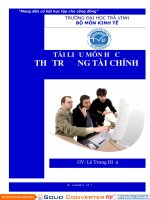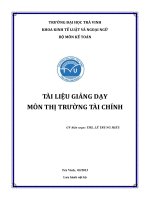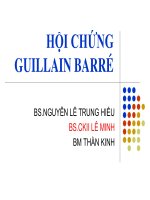Individual essay le trung hieu AEn T122WSB 06 WSU21000053
Bạn đang xem bản rút gọn của tài liệu. Xem và tải ngay bản đầy đủ của tài liệu tại đây (51.1 KB, 7 trang )
Individual essay
Le Trung Hieu
Western Sydney University; University of Economics HCMC
T122WSB-06: Academic English
Gabriel Ryan
April 11, 2022
Data extraction from educational domains is becoming increasingly important in today's world.
Modern educational organizations assist decision-makers in obtaining the proper knowledge and
making the best judgments via the use of new modern techniques such as data mining methods,
which are critical to the development and enhancement of the educational system (Veeramuthu and
Periasamy 2014). We live in a world that is data-driven and information-rich. Data mining,
according to Witten and Frank (2000), is a procedure for extracting previously unknown, usable,
and intelligible knowledge from large and diverse data warehouses. As technology becomes more
interwoven in people's daily lives, data about their activities is being collected, accessed, and
misused. As a result, discussing data mining is crucial. This article will cover all you need to know
about data mining, including what it is, how it works, data mining techniques, the benefits it gives,
data mining tools, and so on.
Data mining has several advantages for corporations, communities, cultures, and citizens. Data
mining has grown in popularity as a result of the expanded and extensive usage of technology.
Companies are now examining their databases for trends, relationships, and consequences to
improve their overall operations and identify new patterns that may help them better serve their
consumers. The first is effective client relationship management. It not only assists firms in
determining which kinds of customers to target with various items, but also assists businesses in
determining alternative marketing techniques based on the demographics of their clients. Customers
follow current market trends, so marketing and retail are dependent on them. These sectors may use
data mining to uncover the right trends through market research, which helps them create marketing
tactics. It also enables them to foresee trends and goods that might be of interest to customers. This
aids businesses in deciding what sort of product to launch. Data mining may be used to compare the
information acquired about your firm with that of your top rivals. One method that may be
employed is data mining. You can enhance your marketing, provide better products and services,
and even reinforce your brand using this information. Data mining has several advantages in terms
of personalization and consistency with current and future customer demands. As a result, a detailed
understanding of the customer's behavior, qualities, and preferences is the only way to win and keep
them. Data mining may be beneficial to a variety of financial firms. Banks and credit card
businesses can access loan information and determine a customer's creditworthiness. It also aids
credit card companies by supplying information on the scam. The most significant advantages of
data mining are that it aids financial firms in reducing their losses.
However, there are certain disadvantages to consider. With such a massive volume of data being
created every day, it is self-evident that there will be significant costs connected with its storage and
upkeep. Your organization will require the right professionals to do data mining properly.
Depending on the sort of data you want to gather, you may need to make an effort, or the initial
investment in data collection tools may be prohibitively expensive. Furthermore, businesses have
access to a wealth of vital information on their customers and staff. As a vast quantity of essential
data is stored in data mining systems, there is always the risk of it being hacked. Furthermore, it is
well acknowledged that data mining collects data about people using market-based strategies.
Organizations collect data on their customers in a variety of ways to better understand their
purchase habits and much more. However, collecting this information in an unethical manner and
then utilizing it for personal advantage is a violation of user privacy. Finally, data mining
technologies evaluate data without knowing what it means. These patterns, however, are not
relevant in and of themselves, but only after the user has evaluated them. Inconsistent or erroneous
findings are the result of preprocessing problems. In practice, improper data entry frequently causes
issues. It's hard to derive representative knowledge from non-representative consumer data, for
example. As a result, using erroneous information in decision-making might have catastrophic
implications.
Despite the fact that data mining is still in its infancy, firms across a wide range of industries,
including retail, banking, health care, manufacturing, transportation, and aerospace, are already
utilizing data mining tools and techniques to exploit historical data. (Liao et al., 2012) presented a
state of the art in data mining that "concerns a series of works fulfilled throughout the past decade".
Data mining lets analysts identify crucial facts, correlations, trends, patterns, exceptions, and
anomalies that could otherwise go unnoticed by sifting through warehoused data using pattern
recognition technology and statistical and mathematical methodologies. Data mining is a technique
for identifying patterns and correlations in data to aid in the making of better business choices.
Data mining may aid in the detection of sales patterns, the development of more effective marketing
efforts, and the precise prediction of consumer loyalty. For firms that use social listening, trend
analysis may be a critical statistic. Businesses, for example, might look at which subjects, mentions,
and keywords are now popular on social media and use mining techniques to figure out why. This
insight may be incredibly telling; let me give you one of the most well-known instances of what I'm
talking about. Trend analysis allows us to perceive things from a fresh perspective and uncover
hidden truths. Even the social media networks that we use on a daily basis profit from data mining.
One way to do this is through the identification of social spam. Bots are constantly exploiting
weaknesses in these systems to send unpleasant, repetitive, and pointless content to consumers.
Because of how sophisticated automation has gotten, discovering and eliminating these bots might
take some time.
As a relatively new topic of research, social media data mining has produced several obstacles and
issues in terms of its application for various objectives. One of the most serious issues with its
application is the question of whether or not mining social data is ethical. As previously said, social
media data mining makes use of a significant quantity of publicly available user-generated data,
which implies that users have decided to publicly disclose their data and are aware that anybody
may see what they've posted, commented on, or shared on social media platforms. However,
perceptions of what is "public" and "private" continue to differ, which, when combined with issues
of ownership and intellectual property, the difficulty of ensuring anonymity, and the difficulty of
obtaining consent through informed choice, all pose additional challenges for data
miners.Furthermore, the lack of a defined ethical framework for dealing with social media data adds
to the difficulty of collecting, analyzing, and presenting user-generated data.
To conclude, for enterprises, researchers, and government agencies to benefit from the advantages
of social media data mining, clear ethical norms and regulations controlling the use of social data
must be adopted. In these days of big data, it is difficult to uncover data that is relevant to your
objective. As a result, data mining is a great way to speed up the process of analyzing and applying
relevant data. On the contrary, as previously said, it does have certain restrictions. Though the
benefits of data mining exceed the drawbacks, we urge you to think carefully before starting a new
data mining project.
Reference List
How to apply for an MBA: A student perspective. Business Blogs - Social Media Data Mining:
Understanding What It Is and How Businesses Can Use It - University of San Diego. (2020,
April 3). Retrieved April 11, 2022, from />_focus=76022
Hoffman, J. (2022, March 22). Know the pros and cons of Data Mining. WisdomPlexus. Retrieved
April 11, 2022, from />
Liao, S.-H., Chu, P.-H., & Hsiao, P.-Y. (2012, February 27). Data mining techniques and
applications – a decade review from 2000 to 2011. Expert Systems with Applications.
Retrieved April 11, 2022, from
/>
RMIT. (n.d.). Retrieved April 11, 2022, from />Social Media Data Mining: What It Is, How It Works, and How to Use It | Blog | Whatagraph.
Whatagraph.com. (2022). Retrieved 11 April 2022, from
/>
Veeramuthu, P., & Periasamy, D. R. (2014). Application of higher education system for predicting
student using data mining techniques. Semantic Scholar. Retrieved April 11, 2022, from
/>









